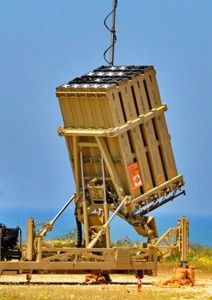Since the late 1980s, Israeli defenseexperts maintained that short to medium range missiles and rockets would be the dominant weapons threatening the Israeli home-front in the future. This notion materialized during the 1991 Gulf War, when 39 Soviet made Iraqi Scuds exploded throughout Israeli cities and towns. After this watershed moment, various Arab regimes and militant organizations began to stock pile such missiles and rockets in anticipation of any future confrontation with Israel. To counter the perceived threat, Israel developed a new defense doctrine, one that is pro-active and multi-tiered.

Israel’s first system was the single-stage testing platform Arrow I missile, which was later developed into the dual stage Arrow II. This system has an operational range of 90-148 kilometers and a flight ceiling of 50-60 kilometers. Both the range and flight ceiling are dependent on the ballistic profile of the incoming threat. Testing of the system indicates that it is capable of intercepting 90% of incoming threats.
In 2009, the Israeli aerospace industry began to develop the Arrow III, which is capable of operating as an exo-atmospheric interceptor that contains a maneuverable warhead. Due to its capacity to operate in the exo-atmosphere, it is supposedly able to intercept an incoming threat before it reenters the Earth’s atmosphere.
Israel’s second operational missile defense system is the Iron Dome, which was developed to counter heavy mortars and short-range rockets. The system has gained much media attention both in Israel and abroad, following its relatively high-rates of success in intercepting numerous rocket attacks from the Gaza-Strip since 2011. During the last round of hostilities between Israel and Gaza-based militants in March 2012, the system proved to be 75-85% effective in intercepting the incoming short-range rockets emanating from the Gaza Strip.
To close the gap that existed between the short-range and long-range missile defense systems, the Israeli aerospace industry is also developing the David Sling medium-range defense system. The expected operational range is 70-250 kilometers with the ability to intercept aircraft in addition to rockets and missiles. The system is being developed in coordination with American missile manufacturer Raytheon, and is codenamed “Stunner”. The David Sling (Stunner) was built specifically to counter Hezbollah rockets, which are able to reach Israel’s major urban centers, and in-fact are reportedly nearly covering Israel’s territory in its entirety.
During any conflict, the aforementioned systems are expected to be supported by the American Patriot air defense system and the Aegis combat system. Despite the large investment in pro-active defense technologies, Israel did not neglect its more passive safety precautions, such as bomb shelters, gas masks, and most importantly, educational safety guidelines during a missile attack.
All cases of fatal injuries or death following recent rocket attacks were the result of residents either not protecting themselves according to the Home-Front Command’s guidelines, or lacking the ability to make it to their protected area on time. For this reason, If currently working or visiting in Israel, especially within the 40 kilometer radius of the Gaza Strip, it is advised to be familiar with all safety protocols as they pertain to missile defense and early warning sirens.